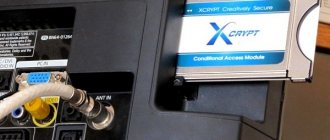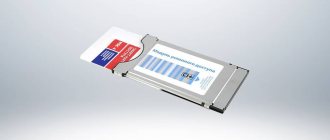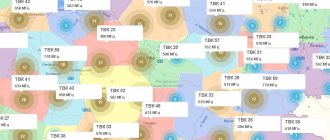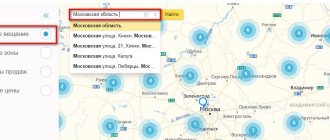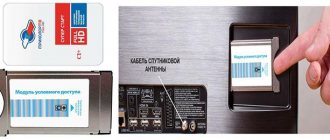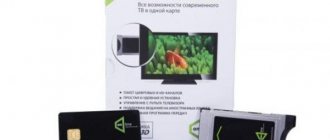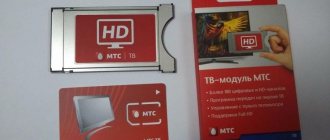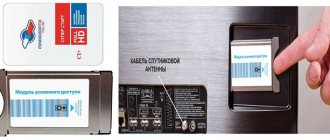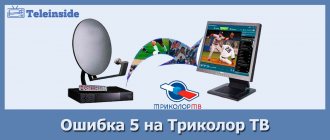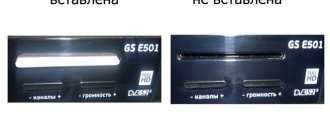A smart card is a plastic card with a microchip installed in it. Such frames are designed to control and record data, and they are often capable of performing cryptographic calculations. A smart card can perform various functions to process information and then save it. The name itself speaks about the capabilities of the card, since Smart means “intelligent”, i.e. smart card is smart.
What is a smart card and how is it used for digital TV viewing?
A digital television (DTV) smart card is a small plastic card that contains a chip with integrated electronic circuits. Many models of this device have a microprocessor in their design, as well as a special operating system, with the help of which the device is controlled and access to stored objects is constantly controlled.
Smart cards for receiving digital broadcasting are devices that provide access to various paid channels, the package of which is selected by the user. Thanks to them, the picture turns out clear and bright: they pick up TV broadcast signals without glitches, so there is no flickering on the screen and the colors are not blurry.
Such a card can be obtained from both satellite and cable television providers. The company logo is applied to its front side, and an electronic chip is attached that stores access codes in encrypted form. A personalized number, as well as different provider code systems, help to significantly reduce the risk of hacking access to viewing paid channels.
Smart card for MTS TV
Benefits of using SMART cards
Smartcard has the following list of advantages:
- The ability to independently select the list of paid channels to which you require access.
- Gaining constant access to high-quality digital broadcasting, characterized by improved clarity, as well as an almost complete absence of interference and distortion, the picture is obtained with good sound and brightness.
- If necessary, you can independently disable and connect certain pay TV channels.
- All users receive a text version of the TV program of films and programs, which is broadcast on the TV screen (this function depends on the provider and model of equipment).
How is a smart card used in a TV?
In order to use a smart card from a particular digital and cable television provider, you do not need to have any special skills: you first need to insert it into a slot designed directly for this card or into a special set-top box, and then configure the device according to the instructions.
For the smooth and correct functioning of the card, you need to monitor not only the serviceability of the access device itself, but also that the package of services is paid for on time. Otherwise, the system may malfunction.
All smart cards that providers give to their clients are unique, making it absolutely impossible to replace them with other cards. Therefore, it is necessary to use only registered and activated cards that have no visible damage on the surface. In this way, difficulties that prevent access to the content of selected pay TV channels can be avoided.
Long history of introduction
The introduction of an electronic passport in Russia has been talked about for almost 10 years. In 2013, a concept was approved according to which a gradual transition to an electronic passport was planned from January 1, 2016. However, the deadlines were constantly revised.
The Ministry of Internal Affairs stated that the electronic passport will be similar in appearance to a bank card, on which passport data will be printed: photo, last name, first name, patronymic, date and place of birth. The information will be duplicated on an internal chip, which will also contain the person’s biometric data.
This type of passport has a number of advantages. General Director of ANO Digital Platforms Arseny Shcheltsin explained to 360 that when using an electronic ID card, all processes are stored in one place and the passport will not be subject to any defects. Another plus is quick identification.
Registration at the hotel can be carried out quickly and without saving your passport data. Only special keys will be saved that identify this user as a citizen with such and such full name, date of birth
Arseny Shcheltsin.
There are risks associated with the introduction of new passports. In 2021, Deputy Prime Minister Maxim Akimov stated that a special electronic passport application for all mobile platforms would be released for the card.
Now, digital ID can be embedded in a QR code on phones. Such an innovation may lead to the loss of personal data. Shcheltsin recalled that using a passport you can sign up for an apartment, and an electronic digital signature allows you to do this.
“If the passport is in a mobile device, then we will open a Pandora’s box in which tens of thousands of apartments can flow from one owner to another,” Shcheltsin said.
The specialist noted that if an application or other form of storing passport data on the phone appears, the mobile device will have access to this information, so it is better to use less important government services on foreign-made smartphones.
Smart Card Readers
A smart card reader is a device that is designed to read and decrypt information contained on such a card. The latest models are excellent for reading various crypto and microprocessor smart cards.
Based on functionality and technical characteristics, two types of devices are distinguished:
- Contact devices are devices that are used in cases where operations require reliable information security.
- Contactless smart cards are devices that allow users to transmit information via radio signals.
Cable and satellite television providers offer mainly contactless models, the power of which is sufficient for quick reading and subsequent decoding of information.
In addition, they are more convenient to use compared to contact-type readers. After all, data is transmitted by radio signals over a considerable distance.
Therefore, with just one smart card, you can watch several TVs located in different parts of the house.
Smart card reader
The latest TV models have special CI/PCMCIA connectors for the CAM module. However, for older models you need to purchase a special receiver (TV set-top box), which is connected to the TV using a cable.
Examples from other countries
Now residents of many countries have electronic passports. Since 2007, the United States has issued mandatory electronic passports that include information about the owner.
The situation is similar in Austria and Germany. In Austria, you can get a citizen card and use it to sign documents with an electronic signature, receive government services and undergo identification. And in Germany, the personal identification card even indicates the height and eye color of the owner.
Electronic passports in the form of cards have begun to be used in many CIS countries. In Kyrgyzstan, the transition process began in 2017, and two years later, almost every fifth person had a plastic document with them.
Even earlier, Kazakhstan and Armenia switched to cards. Residents of Kazakhstan began receiving cards in 2009. In Armenia, a similar process began in 2008.
Setting up and activating smart cards on different TV models
You must insert the card into the TV that is unplugged. Then turn on the receiver again and the card will be recognized automatically. Then TV channels are tuned. There will be slight differences in settings due to different models of receivers. Let's consider popular models:
- If the TV is LG, then find “Auto setup” . Next, you are prompted to select a country. It is necessary to focus on countries such as France, Switzerland, Finland or Sweden. The type of channels is digital, and click “Search” .
- Samsung receivers require initial entry into the “Channel” , and then into automatic tuning. Digital broadcasting and full search mode are also selectable. The whole process will take a few minutes.
- The tuning of the Phillips model proceeds in a different direction. First select "Configuration" from the menu. Next comes “Installation” and “Reinstallation of channels” . The country to choose from can be Russia, Germany or France. The setup ends with digital broadcasting and search being installed automatically.
- The Sharp receiver requires a country to be specified in the settings, such as Sweden, Finland, France. Then “Automatic installation” and click on the “Ok” .
Attention! You should disable updates that occur automatically, as all found channels are reset.
The most important thing is to choose the signal type, mode, automatic search.
Advantages and disadvantages of using cards
Benefits that users who connect a smart card receive:
- Digital TV can be viewed in high definition;
- no interference in bad weather conditions;
- You can choose paid channels yourself: connect or disconnect them;
- if you change the card, you have the opportunity to choose another provider;
- there are additional services;
- Smart cards can be used for many receiver models.
The disadvantages of the card are that it can be broken or lost. Then you will have to change it to a new one. There is usually printed information on the plastic about how to use the card correctly. Important rules:
- avoid exposure to moisture;
- the card must be activated.
Where is the SMART card installed if the TV does not have a corresponding connector?
If the TV does not have a CI/PCMCIA connector for the CAM module, the user must purchase a TV set-top box (receiver) to be able to connect digital broadcasting.
It’s not difficult: today there is a wide range of devices on the market that meet any requirement. There shouldn't be any problems with either. Some providers, for example MTS, upon connection, install their own TV set-top boxes for subscribers, including payment for using it in a monthly payment, or providing it free of charge (usually during the period of company promotions). Installing a smart card and CAM module into the receiver is similar to connecting through the connector on the TV panel.
Thus, almost any user can connect digital broadcasting at home, regardless of the TV model. A SMART card that allows you to control paid channels with increased definition ( HDTV) can be installed either directly into the TV itself, via
CI/PCMCIA connector and TV set-top box.
In the second case, the user will have to control the channels using two remote controls or buy and.
Now all TVs with digital tuners have such an electronic module with a slot, a CAM module is installed in the slot, and an access card is installed in the module.
CI - Common Interface
is a technology that allows you to view encoded television signals, that is, television programs provided for viewing to users on a paid basis. Currently, the CI interface is a thing of the past and has been replaced by an improved CI+ interface.
The difference between them is that CI Plus
or
Common Interface Plus
implements a form of copy protection between the Conditional Access Module (CAM) and the television receiver. The CI+ standard is compatible with the CI of older television receivers that have CI.
Together with a CI slot, it can be used with CI + CAM, and vice versa, but only those television programs that are not marked as CI + will be available for viewing.
CAM module IRDET0
Viaccess CAM module
There are many types of CAM modules; modules are usually produced for a specific encoding protocol; even cable providers produce their own access modules.
How does TV decoding work?
When a receiver (tuner) receives an encoded TV program, it needs to know the encryption algorithm to process the signal correctly.
Leading encodings use the following encoding principle: a request is sent with the television signal to obtain an access key, for example, once every 3 minutes, the receiver, having received a request from the air, submits a request to the CAM module, the module accesses the access card, having received information from the card, the module generates a response code access, which is transmitted to the receiver (tuner). The tuner understands which signal decoding algorithm should be used and decodes the television signal.
Modern systems also implement the transfer of information about active cards. Example: you bought access to NTV with a monthly subscription, but you forgot to pay the monthly fee. When receiving a TV signal, information will be transmitted that your card is not active and you cannot watch TV programs. After payment, your card number becomes active and you can watch TV shows again.
You have seen everything many times and, perhaps, even used telephone cards for calls, travel cards on the subway, or received cash from an ATM. These are all smart cards.
The plastic card received the prefix “smart” from the English smart
- mind, intellect, i.e. smart card. This intelligence is given to the card by the microcircuit that is built into it. Schematically, a smart card is like this:
All smart cards can be classified according to several main characteristics:
- chip type
- way of reading information
- compliance with standards
- Areas of use
Based on the type of chip, smart cards are divided into the following:
- Memory cards
are cards designed for storing information.
Depending on the type of memory, only read operations are possible ( ROM
), write once (
PROM
EEPROM
memory ), but you can read naturally without restrictions. In general, these cards have little or no security, and have simple byte-byte memory addressing, which makes accessing information fairly easy. - microprocessor cards
- in principle, these are also memory cards, but they have much more capabilities for restricting access.
Almost all such cards have a developed memory structure, represented as a file system, where any area of the card's memory is represented as a file with a certain type of access that the user can get after the authentication process. Often this can only be achieved by having a developed microprocessor, which is why they are called microprocessor-based. I will say more, there are cards in which, using the built-in virtual machine, you can run your own programs written, for example, in the Java
(such cards are called
Java cards
) or in your own language supported by the card. Such cards can allow you to implement almost anything; they usually have a fairly large amount of memory and, in their architecture, can easily pass for a full-fledged autonomous computer with all the ensuing consequences. - cryptographic cards
are a type of microprocessor cards that have either very little memory or no memory at all, although it all depends on the manufacturer and the amount of memory is not the main thing. The main area of application of these cards is the development of cryptographic keys, electronic signatures, or even direct participation in the process of encrypting information. Because of the freed up chip space from less memory, the manufacturer can implement a better cryptographic algorithm or several different algorithms than conventional microprocessor cards use.
Based on the method of reading information, smart cards are divided into several classes:
- Contact cards
interact with a reading device by direct contact between the metal contact pad of the card and the reading head of the device. This reading method is the simplest, so contact cards, and especially readers, can have a low price. But this method of exchanging information has to be paid for by wear on the contacts, and as a result, gradual wear of the card or reader with frequent use. As a rule, the wear resistance of the card and reader is several hundred thousand operations. - Contactless cards
interact with the reader using radio waves. To operate the antenna, cards of this type may have their own battery, or they may be powered by the reader; in this case, the card antenna is made in the form of an inductance coil, which begins to generate electric current while in the strong electromagnetic field of the reader. Naturally, cards without batteries can work for an unlimited amount of time, while the former lose battery power and quickly become unusable. These cards are of course more durable than contact cards. In addition, they provide faster operation, because they operate at a distance and do not require laborious insertion into the reader. That is why these types of cards are often used in systems for controlling the passage of people (take, for example, the subway or the checkpoint of a large factory). - Cards with dual interfaces
have both contacts and an antenna “on board”, ensuring the card works with any type of reader. In this case, one feature should be noted. Cards with a dual interface can have one microprocessor or two separate ones, and they can be interconnected by a common memory or work autonomously, i.e. then the non-contact part will perform some functions, and the contact part will perform others. For example, a contactless microprocessor can be used for an access control system to the doors of some facility, and a contact chip for working with a computer, for example, it could be a cryptographic card for generating an electronic signature.
The next division of smart cards occurs according to standards. There are several international standards for smart cards. Each of them determines everything from the size and type of plastic to protocols for working with the card and data formats. Today there are several standards for smart cards:
- ISO-7816
- "Identification cards - cards with chip and contacts." Consists of six parts, describing physical characteristics, pin size and arrangement, signals and protocols, file structure, addressing and communication commands. - EMV
(Europay, MasterCard & Visa) - Parts 1 and 2 are based on ISO-7816, later ones add transaction processing definitions, terminal specifications, etc.
There are, of course, smart cards that do not comply with generally accepted standards, but such smart cards are supported only by their manufacturer and the scope of their distribution is quite small; often they are simply adapted for a very small and specific task, i.e. their widespread distribution is not obviously envisaged.
The division by area of application is quite arbitrary, because most smart cards have such a unified structure that they can be used almost anywhere. However, in order to at least approximately understand their scope of application, let's look at some of them:
- Security
is undoubtedly one of the main uses of smart cards. It is the ability of cards to safely store and process information that allows them to be used in other areas. In security tasks, smart cards play the role of some identifiers that cannot be copied or forged. - Finance
- well, of course. This area has long been a stumbling block for the entire global financial community, because the idea of “electronic money” will reduce overhead costs associated with security, transportation and production of money, and how many green trees will remain to grow in their place. Smart cards can really help a lot in this case. - Customer cards
are a very fashionable trend in any business these days. Indeed, by handing your client a beautiful card, you seem to unobtrusively “tie” him to you, because your card is nothing more than a permanent advertisement in the client’s pocket or wallet. In addition, by throwing a few percent discount on services or goods to such a client, you can confidently expect him to appear again. Such “loyalty” programs really work, and smart cards will allow them to be implemented very quickly and easily. - Telephony
- smart cards are widely used in this area. This includes cellular communications, where SIM cards are inserted into mobile phones. And payphone cards for time-based call payment and much, much more. - Transport
- smart cards are still not widespread in this area. Basically, contactless smart cards are used for these purposes, because only they can cope with a large flow of passengers. The practice of introducing such a system in the Moscow metro shows that this decision has the right to life. - Healthcare
- in Russia we have already introduced some kind of “card” system, I hope everyone has a plastic insurance policy card with a personal number. But while this is just a piece of plastic, smart cards will allow you to create an entire medical record of the patient with a medical history, test results, and also written prescriptions. Imagine how cool it is, the doctor wrote down a prescription on your smart card. You go to the pharmacy and, without remembering the complex names of the drugs, simply insert your card into the reader, after which you immediately receive your set of drugs or their similar substitutes. After recovery, you can safely give your card with records of illness to your superiors, as a sign of proof that you really were treated and did not fool around.
But while this is just a piece of plastic, smart cards will allow you to create an entire medical record of the patient with a medical history, test results, and also written prescriptions. Imagine how cool it is, the doctor wrote down a prescription on your smart card. You go to the pharmacy and, without remembering the complex names of the drugs, simply insert your card into the reader, after which you immediately receive your set of drugs or their similar substitutes. After recovery, you can safely give your card with records of illness to your superiors, as a sign of proof that you really were treated and did not fool around.
As you can see, the scope is wide. You can use smart cards anywhere and anytime. Moreover, the implementation of such an intellectual component can always benefit your business. Think a little about where you could use them.
